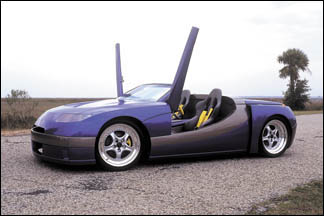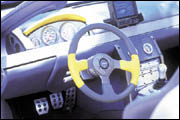

In the fast lane
SCAD's product design department offers students life in the fast
lane

Photo courtesy of Savannah College of Art and Design
The EXO Spyder was designed by former SCAD graduate student Ed Bigda,
and based on a Pontiac Fiero chassis that has been modified.
Buffing and polishing the EXO Spyder is a tough job - the car has an extra glossy paint job. Yet, Savannah College of Art and Design student Robin Roberts doesn't mind the work, even though he's never gotten a chance to ride in the car.
The attention Roberts pays to the Spyder, designed by product design/interior design professor and former SCAD graduate student Edward Bigda, is well worth it, he said.
"It's a labor of love," Roberts said.
Bigda and the 6 students who help him maintain the car will have a lot to prep for. The EXO Spyder, which has attracted the attention of the Motorweek Car Show, is expected to travel this spring to the Daytona Beach Car Show, the New York International Auto Show and the Eyes On Design Car Show in Detroit.
"Preparing the car might not sound like a lot of work, but it is," Roberts, who will be a senior in product design next quarter, said. "We've put in a few 48-hour work sessions while working on getting it show-ready. I don't know if people realize how difficult it is to keep it that way. Under the show lights all of a sudden you notice everything - it can be a fingerprint in the middle of the hood and you can't take your eyes off of it."
 Roberts and other students make sure the
car is clean inside and out, just in case someone wants the thrill of sitting
inside the car. However, Bigda is the only one allowed to drive the EXO
Spyder.
Roberts and other students make sure the
car is clean inside and out, just in case someone wants the thrill of sitting
inside the car. However, Bigda is the only one allowed to drive the EXO
Spyder.
The car was conceived by Bigda as part of one assignment, and made into a thesis project. It's based on a shortened, reinforced Pontiac Fiero chassis, although it's about a foot shorter and 400 pounds lighter with a souped-up V-6 engine.
Although many of the students who worked on the project have graduated, others such as Damon Jurkiewicz, Chaz Mello, Brandon Hatcher and Michael Burnett continue to work on it. Roberts, who began working on the car a month before the end of the nine and a half month-long project, thinks the opportunity presented by it was beneficial because it gave students a "real world" experience.
"We had the great fortune of working with professionals in the field," Roberts said. "They showed us what could and couldn't be done and what should and shouldn't be done."
For the most part, everyone in the product design (formerly industrial design) department had a hand in some aspect of the car's production, Roberts said. Under the direction of chair Victor Ermoli, the car was taken from the drawing board to a foam model to fabrication of parts, including the bolt-down system for the seats. It was a true collaborative effort, involving nearly half the department's on campus and about four dozen students and faculty.
"There was a lot of time spent drawing, discussing, arguing, literally deciding what this car was going to look like," Roberts said. "There was a lot of dedication and work put into this project. We do that with every project we do."
The Spyder experience not only was beneficial to students in their instruction, but it also added credibility to the program's reputation, Roberts said.
"It's a pretty big step for a program as young as we are," he said. "It puts the spotlight on us and on the college. It's going to be sort of a legacy. It's very exciting, the fact that our department has a car. Now, we're well on our way."
Since finishing the Spyder last April, Roberts has also worked with Tupperware and Delco/Delphi on class projects. He hopes that the program gains more notoriety with larger companies now that the students have managed to accomplish such a big project as the Spyder.
"Doing this real world stuff is exciting to me," Roberts said.
The field of product design includes nearly any consumer product imaginable - from cars to toothbrushes to cigarette lighters. Working with companies now not only helps give students an idea of what to expect when they enter the field, but it gives them an opportunity to develop their skills in a way that a typical classroom setting cannot.
Margarita Venegas can be reached at 525-5500 or by e-mail to mvenegas@georgiaguardian.com